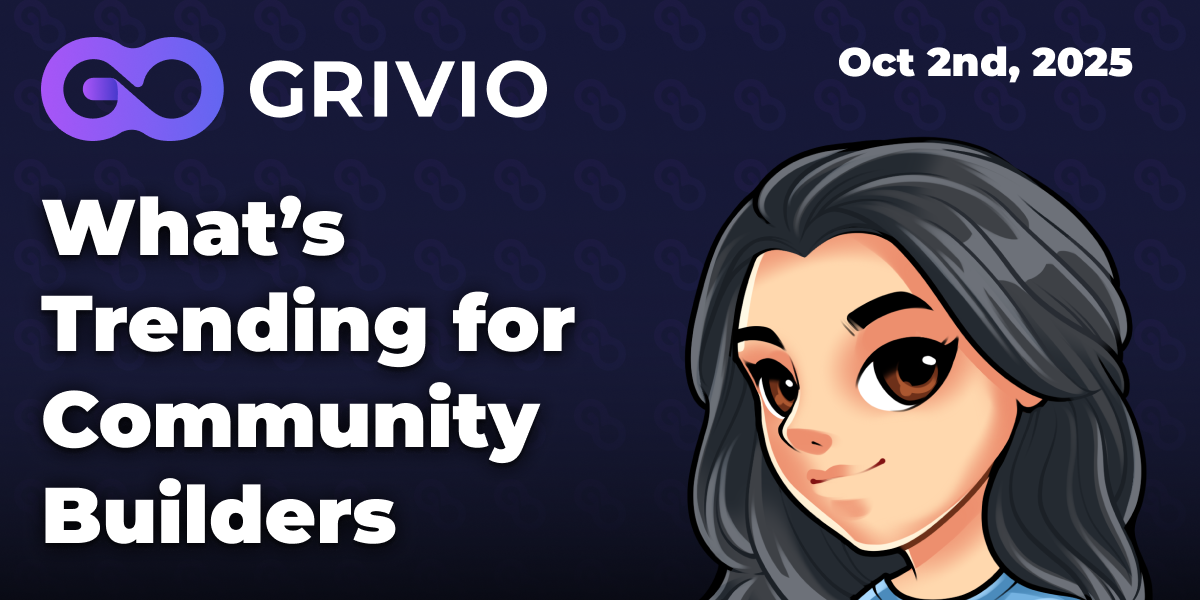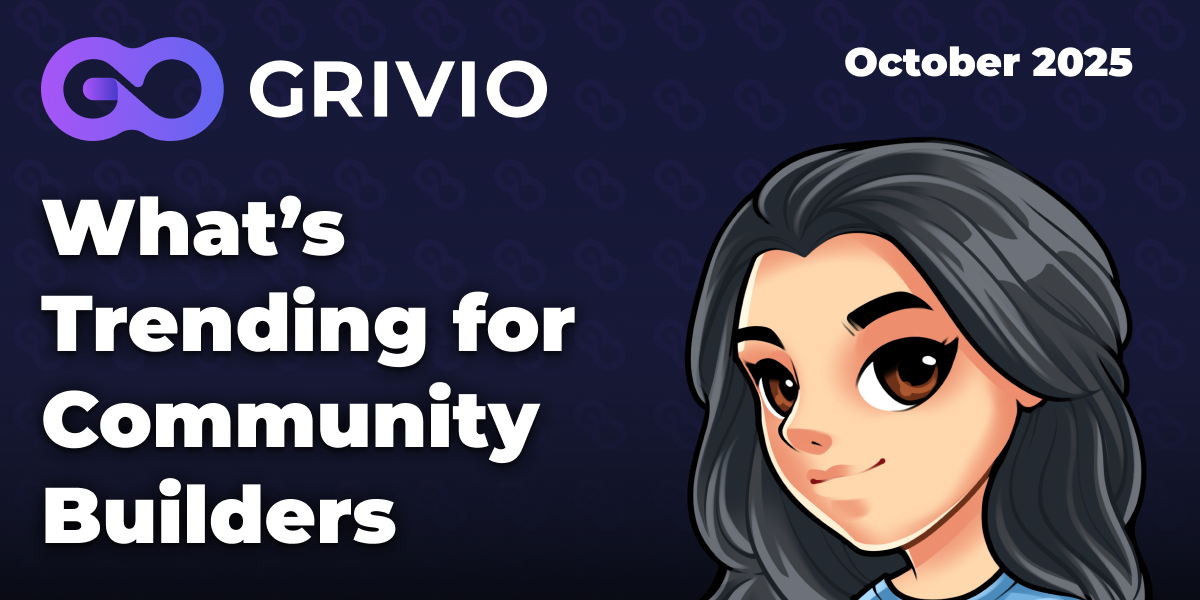What's Trending for Community Builders - October 2025
shylor • October 22nd 2025

Grivio connects you with vibrant communities of Grivians who share your unique interests, no matter how niche.

November 22nd 2025

October 3rd 2025

May 23rd 2025
shylor • October 22nd 2025

Welcome to the Grivio Digest with Claudia
Every two weeks, Claudia tracks emerging trends across online communities, spots opportunities you can act on, and connects the cultural dots that matter to community builders like you.
Whether you're running a Discord server, building on Twitch, or managing communities across platforms, this is your pulse check on what's actually happening—and what it means for your community.
Your Discord went quiet in early September, then exploded with horror content by mid-month. If you thought you'd missed the Halloween window, think again.
This October is different. Gaming communities are having an unprecedented moment, creators are rewriting the monetization playbook, and your members are telling you exactly what they need—if you know how to listen.
Horror Gaming Hit Early and Never Stopped
October 2025 is unlike any gaming release month we've seen. Dead by Daylight commanded 291 million TikTok views and 62,000 posts in seven days. Horror gaming content usually peaks in late October. This year, the wave began in mid-September and continued to build.
Silent Hill F moved over a million copies in its opening week by delivering pure atmospheric dread—what the 2024 remake missed. Then Little Nightmares III dropped on October 10th with a design choice that forces community building: mandatory online co-op. No solo mode. You must find a partner and finish the game together with the same person.
The Friend's Pass makes it accessible (only one player needs to own the game), but the commitment stays high. Players coordinate schedules and communicate through tense puzzles where both must work together. The official Discord already has 3,543 members organizing partner-matching.
Meanwhile, Battlefield 6 is setting a new standard. The game is trending not just for gameplay, but for something community builders should study: rapid developer response to player feedback. Across PC, PlayStation 5, and Xbox Series X|S, the dev team is creating a post-launch environment where players feel heard immediately. That's the bar now.
The Creator-Partnership Model That Changes Everything
Waterpark Simulator embedded streamer CaseOh's inside jokes as Easter eggs throughout the game. When CaseOh (1.2M hours watched) discovered them live, viewership jumped 1,526%.
This isn't clever marketing. It's a new model where communities become co-creators instead of just consumers. CaseOh's audience felt seen, which drove massive engagement and attracted new players who wanted in on the jokes.
This model is spreading fast. Developers are learning that engaged communities with established culture beat raw follower counts every time.
Your Members Are Leaving in the First 90 Days
Here's the number that should wake you up: 68% of newcomers never return after their first post. Members who don't engage within 90 days show 73% higher churn rates. Even worse, 32% of members simply forget about the communities they joined.
Gaming communities during launch windows hit 40-60% daily active users because they provide clear, purpose-driven collaboration. A new Pokémon player asks, "How do I beat this gym?" and gets specific answers. A new brand community member asking "How do I get value here?" faces ambiguity.
The infrastructure exists—Reddit enhanced Mod Tools in September, TikTok launched Creator Chat Rooms globally in July, and Discord improved onboarding flows. Most communities have not yet implemented them.
Gen Z Is Demanding Depth Over Breadth
The "You Need to Nerd Out" trend is exploding across social platforms. Gen Z isn't just tolerating niche interests—they're actively seeking hyper-specific communities where they can go deep.
Successful creators are moving away from performative productivity and toward specialized technical discussion with vulnerability. The key insight: people feel "too anxious to talk over the phone" but crave spaces for deep dialogue about specific passions.
Communities providing safe, non-judgmental spaces for highly specific knowledge are winning. Depth beats breadth.
Vibe Culture Is Replacing Micro-Virality
Engagement is shifting from quick trends to mood-driven moments. Ambient Twitch channels featuring passive cinematic footage (no mic, no facecam) are pulling massive watch times. Viewers leave them running for studying or sleeping.
Lo-fi tutorial content on YouTube links directly to Discord communities for peer technical feedback. The strategic value: viewers feel connected to a "digital hangout spot" without the pressure of constant interaction.
This increases sustained engagement time significantly. Communities that curate long-lasting emotional experiences are outperforming those chasing quick viral moments.
The Great Lock-In has 60% of Gen Z Energized
Started by creator @shmeat27 in August, "The Great Lock In" is a 121-day challenge (Sept 1 - Dec 31) where participants focus intensely on personal goals before 2026.
Here's why it matters: 60% of participating Gen Zers report feeling energized during what's typically the end-of-year slump season. No rigid rules like 75 Hard—participants personalize their approach. Built-in community accountability through shared updates.
Warning: 24% of non-participants view it as toxic and performative. The opportunity isn't pushing extreme optimization. It's creating sustainable accountability structures.
Gaming Shows Us the Blueprint
October's unprecedented release density creates a natural experiment in community formation. Gaming communities organize with remarkable speed because they provide what humans need: belonging, achievement, shared experience.
As traditional third spaces decline, digital communities increasingly fulfill these needs. Gaming just makes the dynamics visible and accelerated.
Battlefield 6's rapid response model proves something crucial: communities stick around when they feel heard immediately. That's your new bar.
The Pattern Connecting Everything
Look at what's working: Little Nightmares III forces meaningful partnerships. The "Nerd Out" trend celebrates depth. Vibe culture removes performance pressure. The Lock In provides accountability without rigidity. Creator partnerships make audiences feel seen.
Look at what's working: Little Nightmares III forces meaningful partnerships. The "Nerd Out" trend celebrates depth. Vibe culture removes performance pressure. The Lock In provides accountability without rigidity. Creator partnerships make audiences feel seen.
What This Means for November
Horror gaming momentum carries through October, then shifts toward holiday content. The creator-partnership model keeps expanding—expect more collaborations between developers and established communities.
Watch for "Vibe culture" to accelerate as year-end stress builds. Communities offering low-pressure ambient spaces will see sustained engagement through holiday chaos.
The lock-in peaks December 31st. Communities that built sustainable accountability structures now will see members stick around in January, while others face typical New Year's Day dropout.
Got feedback or spotted a trend we should cover? Let Claudia know in the comments.